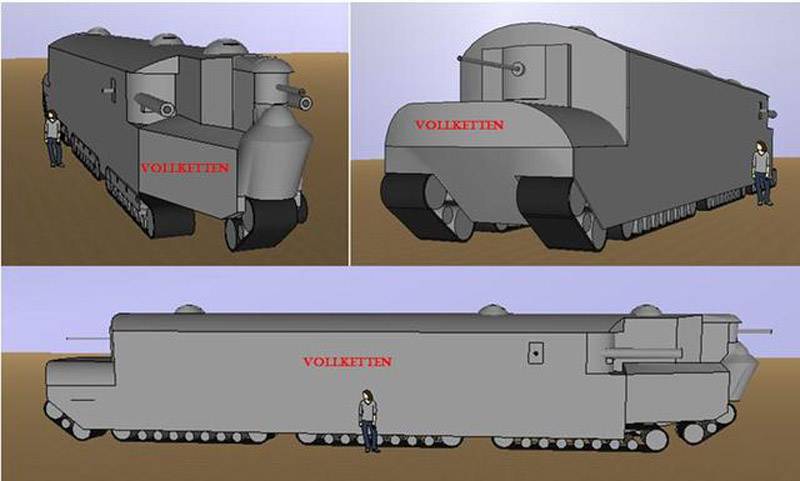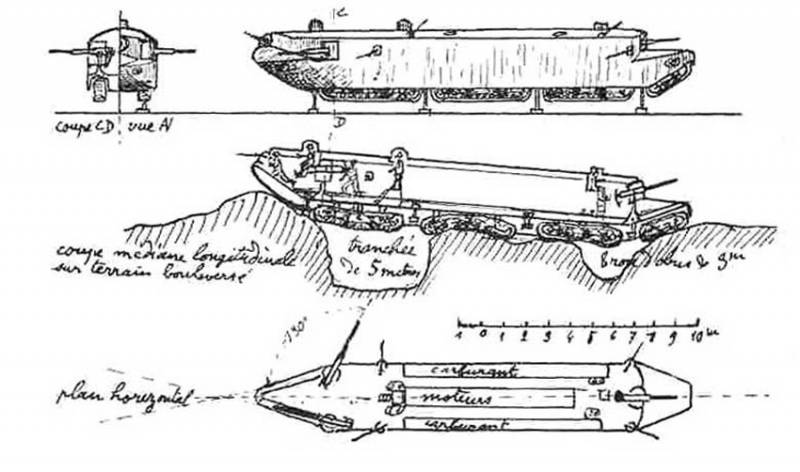Draft heavy tank Ansaldo Torpedino (Italy)
Exact information about some features of the Ansaldo Torpedino project has not been preserved. It is not known who was the initiator of its creation and what design team was engaged in the formation of the unusual appearance of the armored vehicle. Besides, story did not keep accurate data on the timing of the project. It is known that no later than 1917-18's original project was closed due to the lack of prospects. A number of features of the heavy tank-fort did not allow him to enter mass production and operate in the army. Nevertheless, the project is of great interest in the context of the development of early armored vehicles.
Outwardly promising tank-fort Ansaldo Torpedino was supposed to resemble a certain battleship with sufficiently powerful artillery armament. In particular, a large extension casing with a wedge-shaped bow and stern was proposed. The reasons for the appearance of such a design were simple. With the help of a large lengthening, it was planned to improve the permeability while moving over rough terrain, and the wedge-shaped nose of the corps could improve the fighting qualities of the main armament. The project also envisaged various other non-standard ideas.

General view of the tank Ansaldo Torpedino. Figure Aviarmor.net
The tank was to receive a large armor body with a total length of about 20 m and a width of no more than 4 m. The height of the armored vehicle was planned at 4,5 m. An original design of the fore and aft hull parts was proposed, designed to improve the characteristics of artillery and small arms. Devices were also provided for the continuous monitoring of the entire surrounding area. The body was proposed to be made of armor steel of the required thickness, capable of providing protection against small weapons and artillery shell fragments.
The project provided a wedge-shaped bow of the hull. In this case, the lower part of the nose was to be made in the form of a curved piece of complex shape. This detail reached the front elements of the chassis. It was suggested to mount a smaller convex part above it on the nose. Above these units was placed a curved sheet of complex shape with several openings for viewing instruments and artillery systems.
The stern part of Ansaldo Torpedino should have a trapezoidal shape. In the main unit of the stern, assembled from several armor plates, auxiliary tracks of the running gear were to be attached. Above this unit there was a curved top sheet. It was suggested to mount the weapon in a vertical curved sheet. The central part of the hull had vertical sides and a horizontal bottom. The roof should be made convex.
Most of the volume of the body was given under the habitable compartments, performing the functions of the fighting compartment. In addition, part of the volume was to be allocated to accommodate the elements of the power plant and transmission. As follows from the available data, for the most correct use of the available volumes, the engine and transmission should have been located in the central part of the hull. On either side of them could remain passages needed to move around the tank and the use of weapons.
An unusual chassis was used in the Ansaldo Torpedino project. It was proposed to use eight separate tracked carts. They were to be placed in two rows along the hull. As part of the six main carts, mounted under the bottom of the hull, the drive and guide wheels were to be present, as well as seven support rollers of small diameter. In this case, the guide and drive wheels were also used to support the track. The type of suspension proposed is unknown.
Also as part of the chassis should have been used two additional trucks (according to other data, only one). On the stern of the hull two similar units should be installed, having only one track roller. Additional tracked trucks should be installed with some elevation above the supporting surface and at an angle to the horizontal.
The authors of the project believed that the six main tracked trucks would be the driving force of the vehicle and be responsible for moving on different surfaces and areas. To overcome the obstacles proposed to use additional rear carts. With their help, the tank fort could climb some of the elevations and descend from them. To overcome obstacles armored car also had to use a curved lower part of the front of the case, able to slide on the ground. Four pairs of carriages and nasal detail, as it was supposed, could provide sufficiently high mobility and maneuverability in the complex landscapes characteristic of the battlefields of the First World War.
The project proposed an original measure aimed at turning the mobile tank into a stationary firing point. On the lower part of the hull, in front of and behind the tracked carts, and between them, eight retractable jacks were to be located. If necessary, the crew, taking the correct position, could hang out the tank on supports, making it a stationary fort with cannon and machine gun weapons. After completing the combat mission, the tankers could lower the car to the ground and move on.
The Ansaldo Torpedino tank could carry at least six guns of various types. In the original project, it was proposed to equip the combat vehicle with two sets of main gun installations in the fore and aft parts. In the upper front sheet should make an embrasure for large-caliber guns, placed on the thumbnail installation. In front of the sides, two more installations for small-caliber guns were envisaged. The top stern leaf was the support for the third small caliber gun. Two more large-caliber guns were placed in sponsons in the bow of the boards. The design of the hull forehead and sponsons was designed in such a way that the guns could be turned back and almost laid on the front sheets, ensuring the highest possible angles of fire on targets.
Also, the project did not exclude the use of additional weapons in the form of existing or prospective machine guns. The design and layout of the armored hull made it possible to equip it with additional installations for machine guns responsible for firing various sectors. Thus, in the preserved scheme, the prospective tank had two additional machine guns in the sides, in front of large-caliber guns.
A common problem of early tanks was to monitor the situation on the battlefield and search for targets. To solve this problem, the tank-fort was supposed to receive three turrets at once with viewing devices. Two such units were placed in the fore and aft of the roof, next to the gun compartments. Another tower was located in the center of the roof, with a shift to the stern. Three observers had the opportunity to jointly monitor the surrounding area, carry out a search for targets, and also give target designation to gunners or machine gunners.
According to various sources, the total length of the Ansaldo Torpedino fort-tank was to reach 18-20 m. The hull width was about 4 m, the height of the vehicle was up to 4,5 m. The combat weight of such an armored vehicle could be 100 t. , placed special demands on the power of a power plant capable of providing acceptable mobility. Estimated speed and range unknown. Apparently, the heavy tank was supposed to reach a speed of no more than a few kilometers per hour, allowing the infantry to be escorted.
The authors of the project assumed that a promising tank fort could move through complex landscapes and overcome various obstacles. In particular, thanks to several tracked trolleys, a large body length and a curved bottom of the nose, it was possible to cross ditches up to 5 m wide. It was also planned to climb gentle slopes, small walls, etc.
Whether the Ansaldo Torpedino project was considered by the military is unknown. There is information only about the time of appearance of this development and the main features of the design proposed by the authors. Unfortunately, the story did not preserve other details of the project, the chronology of work and data on the consideration of the development of a potential customer. However, the absence of any information about the construction and testing of experimental equipment may be evidence of an unsuccessful completion of the project.
Probably, the management of Ansaldo or responsible military leaders, having considered the original project, refused to further develop it. Naturally, the start of production and operation in the army was out of the question. On the basis of the estimated technical and operational characteristics, this machine was of no interest to the Italian army or other customers.
The surviving information allows us to understand why the Ansaldo Torpedino project has never left the design stage. His main problem was the excessive complexity of design and production. Manufacturing a large and heavy hull as well as a running gear based on eight separate carts could become an almost impossible task for the industry of that time. With a successful solution of the task, there was a risk of an unacceptable appreciation of work. As a result, the tank fort was not feasible for both economic and industrial reasons.

Modern reconstruction of the appearance of the tank Ansaldo Torpedino. Figure - Vollketten / Forum.WoT.com
Another problem that can put an end to the project, can be considered the chassis. The use of a long hull with three pairs of support carriages should have led to serious problems with maneuverability. Making a turn of such a long tracked vehicle is almost impossible, and in addition, leads to excessive loads on the hull and chassis. Thus, the complexity of manufacturing was added to the complexity of operation. It should be noted that the very limited maneuverability could have a negative effect on the survivability of the armored vehicle, which risked becoming an easy target for enemy artillerymen.
Maneuverability and mobility could be further deteriorated by a large combat mass. In addition, 100 T combat masses placed special demands on the power plant. Probably, the tank would have to be equipped with several engines of the maximum possible power, which further complicated the design of the transmission and chassis.
The use of additional supports for the stationary operation of the tank is of interest from a technical point of view, but no more. The practical meaning of this innovation raises certain questions and doubts. You can also find some problems in the proposed weapons complex, etc.
Against the background of these shortcomings, only a few basic features can be considered as positive features of the Ansaldo Torpedino project. It was possible to equip a tank fort with powerful enough weapons, suitable for the destruction of any possible targets. The use of weapons was simplified thanks to a good overview of the three towers. In addition, the crew was protected from a significant number of threats. At this design advantages ended.
The project of the heavy tank-fort Ansaldo Torpedino was not something unusual for its time. During the First World War and at the beginning of the interwar period, numerous designers from different countries offered their versions of promising armored vehicles, including very bold and unusual. Quite often, excessively bold and original ideas made practical use of equipment impossible, which was why the project was abandoned. Such a fate befell many developments, including a number of early Italian projects of heavy-class tanks. As a result, several interesting projects were not implemented and remained in history as technical curiosities. However, they still helped the development of military equipment by identifying and eliminating unviable ideas.
On the materials of the sites:
http://aviarmor.net/
http://landships.activeboard.com/
http://forum.worldoftanks.com/

Information